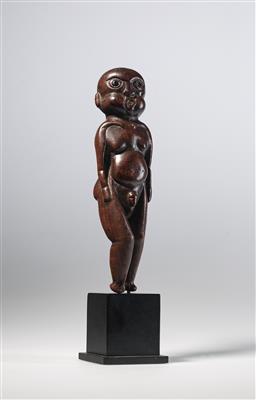An extremely rare Rapa Nui Moai figure, 17th-19th century.

21,5 cm high.
Possibly carved from the small roots of the Sophora toromiro wood, these early figures follow the natural elegance of the hardwood shrubs. This pendant would have been a representation of a spirit. Like the Auku Aku ribbed spirits, these Moai pendants were kept in tapa cloth and stored in the rafters of the house. On ceremonial occasions they were brought out and worn suspended around the neck. There are the four types of wooden moai: the emaciated, long-eared male moai kavakava, the well-fed male with pierced but not elongated earlobes known as moai tangata (image of mankind), the flat-bodied hermaphrodite female moai papa and the birdmen moai tangata-manu. This intriguing figure does not fit any of these descriptions, it is a hermaphrodite figure, with clearly indicated collarbones. It has small earlobes and has an evocative abstraction. The round face, protruding belly probably indicate that this is an early depiction of the earth mother herself. Bibl. Geiseler, Kapitän Leutnant 1883 'Die Oster-Insel. Eine prähistorische Kultur in der Südsee.' Mittler Berlin.
Auctioned in 1968 at Sotheby‘s London, published Mack 1982 "Polynesian Art at Auction 1965 - 1980", no guarantee that it is Toromiro wood.
Provenance:
Carlo Monzino Collection. (VJ)
Specialist: Joris Visser
 Joris Visser
Joris Visser
+32-2-514 00 34
Joris.Visser@dorotheum.com
08.07.2019 - 14:00
- Realized price: **
-
EUR 106,550.-
- Estimate:
-
EUR 40,000.- to EUR 60,000.-
An extremely rare Rapa Nui Moai figure, 17th-19th century.
21,5 cm high.
Possibly carved from the small roots of the Sophora toromiro wood, these early figures follow the natural elegance of the hardwood shrubs. This pendant would have been a representation of a spirit. Like the Auku Aku ribbed spirits, these Moai pendants were kept in tapa cloth and stored in the rafters of the house. On ceremonial occasions they were brought out and worn suspended around the neck. There are the four types of wooden moai: the emaciated, long-eared male moai kavakava, the well-fed male with pierced but not elongated earlobes known as moai tangata (image of mankind), the flat-bodied hermaphrodite female moai papa and the birdmen moai tangata-manu. This intriguing figure does not fit any of these descriptions, it is a hermaphrodite figure, with clearly indicated collarbones. It has small earlobes and has an evocative abstraction. The round face, protruding belly probably indicate that this is an early depiction of the earth mother herself. Bibl. Geiseler, Kapitän Leutnant 1883 'Die Oster-Insel. Eine prähistorische Kultur in der Südsee.' Mittler Berlin.
Auctioned in 1968 at Sotheby‘s London, published Mack 1982 "Polynesian Art at Auction 1965 - 1980", no guarantee that it is Toromiro wood.
Provenance:
Carlo Monzino Collection. (VJ)
Specialist: Joris Visser
 Joris Visser
Joris Visser
+32-2-514 00 34
Joris.Visser@dorotheum.com
|
Buyers hotline
Mon.-Fri.: 10.00am - 5.00pm
kundendienst@dorotheum.at +43 1 515 60 200 |
| Auction: | Tribal Art |
| Auction type: | Saleroom auction |
| Date: | 08.07.2019 - 14:00 |
| Location: | Vienna | Palais Dorotheum |
| Exhibition: | 03.07. - 08.07.2019 |
** Purchase price incl. charges and taxes
It is not possible to turn in online buying orders anymore. The auction is in preparation or has been executed already.
